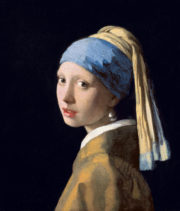In the Low Countries, 4: Postscript— Delft
(I wrote this shortly after our return from the Netherlands at the end of May, 2017)
Last night we finally saw Peter Webber’s glorious film The Girl with the Pearl Earring (2003) — after reading Tracy Chevalier’s novel, which I reviewed in 2001, seeing the original painting in Den Haag, and then visiting Delft, where Johannes Vermeer made the painting in 1665. The costuming, gestures, exquisite performances (especially Scarlett Johansson as the servant girl Griet and Tom Wilkinson as the scurrilous art patron), and the views of Delft’s canals and buildings made us relive our visit to Delft only two weeks ago.
Delft is a mere 18 minutes by “Sprinter” train from Den Haag (The Hague, literally, “the hedge”), where we saw and studied the original canvas of Johannes Vermeer’s “Girl with the Pearl Earring” (1665) in the Mauritshuis museum. Brochures at the museum and in Delft tell us that the picture “is not a portrait but a tronie — a painting of an imaginary figure. Tronies depict a certain type of character…”
Well, maybe. Maybe Vermeer just made up the girl’s features from memory. Or, just maybe, somebody like Tracy Chevalier’s servant girl Griet sat for him. No matter. The novel and the film are deliciously successful in showing us images of what life must have been like in Delft, and in a household such as Vermeer’s, just 20 years into the independence of the Dutch Republic (after an 80-years’ war against its Spanish masters). The pitiless social class distinctions and religious tensions of that time and place are made sharply clear (Vermeer’s household is Catholic, most of their neighbors disapproving Lutherans). The prosperity of that city derived mainly from the manufacture and export of fine tapestries, enhanced by its being the seat of Dutch government since William of Orange established his residence there (1572). (As I said in #3 of this series,) “Delft” by the way derives from the same word that gave us the English “delve”, now seldom used except figuratively, its literal meaning being to dig. The “Delft” was the digging-out, i.e., the canal connecting the town to the Rhine and the Schie and thus to the North Atlantic and its global markets.
(For more on Delft and what made it prosperous, see my review of Chevalier’s novel.)
